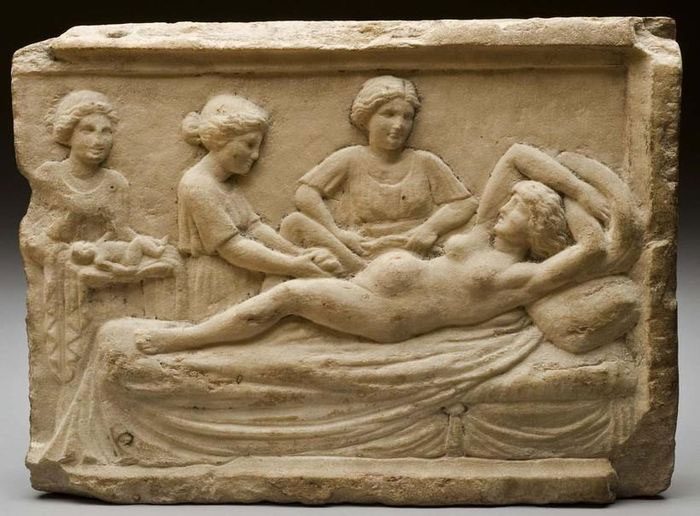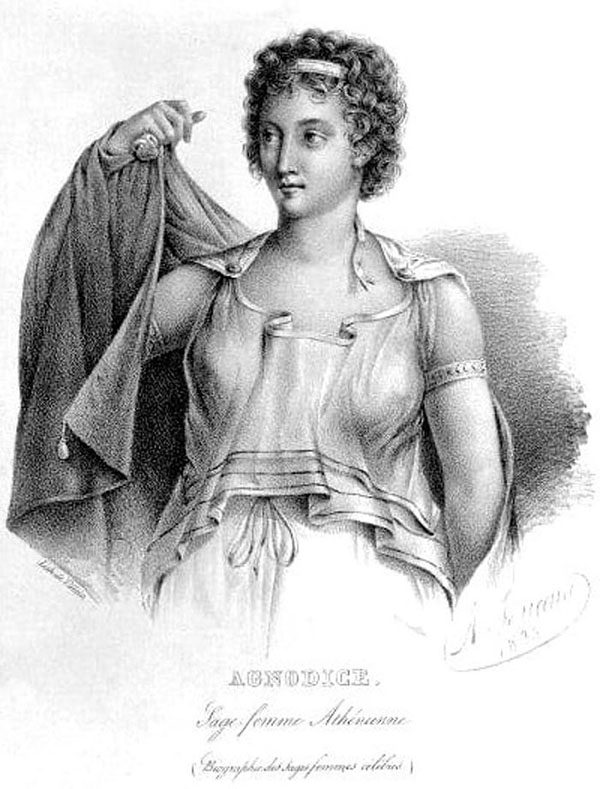Nowadays, the number of men and women studying medicine is almost equal, but many centuries ago, women were prohibited from practicing medicine.
Despite this, a Greek girl living in the 3rd century BC disguised herself as a man to study medicine and is believed to be the first known female doctor in history.
Medicine – A Male Privilege

Childbirth scene in ancient times – a depiction unearthed in Ostia, Italy.
The civilizations of Mesopotamia, Egypt, Babylon, and ancient Greece all had medical training programs, but only men were allowed to study this field.
Part of the reason was that women at that time were not permitted to learn anything, and another part was the belief that they were incapable of grasping the complex ideas in medicine, easily disturbed by blood, and not calm enough to handle illness and injury. Additionally, it was taboo for a woman to look at and touch the body of a man other than her husband.
There was only one area somewhat related to medicine that women were allowed to practice, which was midwifery. Men generally expressed fear regarding the reproductive processes of women, and even educated men were hesitant about concepts such as menstruation, pregnancy, childbirth, and menopause. Male doctors usually did not assist in childbirth until the 1800s.
As a result, for a very long time, this task was handled by women, known as midwives, who passed down their experiences from generation to generation through practical work.
Agnodice could begin her career as a midwife. However, she desired more than just assisting women in labor. She wanted to become a doctor, which was impossible for women at that time.
The only way for Agnodice to achieve her goal was to conceal her gender. Dressed as a man, she studied under the tutelage of the esteemed physician, Herophilos, before practicing medicine in Athens.
Herophilos was a real figure, a famous Greek physician who lived in Alexandria, Egypt. If Agnodice studied with Herophilos, then she would have lived in the 3rd century BC.
Dressing Up to Fulfill a Passion

Agnodice is considered the first female doctor in history.
The Byzantines told many stories about women who supposedly disguised themselves as men to become monks. All these elements suggest that the story of Agnodice should be regarded as folklore. However, for many, Agnodice is a remarkable heroine, inspiring women in medicine for millennia.
According to legend, Agnodice proved to be a skilled and talented physician. She became renowned for her dedicated patient care, especially with female patients.
At this time, complaints about women’s ailments were often ignored by male doctors or regarded as “hysteria.” With Agnodice, female patients found a doctor who listened to their concerns and did not dismiss them.
It is said that Agnodice gained the trust and respect of her female patients by baring her breast to prove to them that she was indeed a woman in disguise.
Rumors spread that Agnodice was an excellent doctor for female patients, which advanced her practice. This prompted the medical community in Athens to question why such a young physician had become so popular.
A group of doctors, having lost many clients, accused Agnodice of seducing their female patients, and she was put on trial for indecency. In court, to defend herself, she argued that she could not seduce female patients, her own gender, and lifted her tunic to prove her identity.
Although she was deemed innocent of the charges of indecency, Agnodice’s defense led to a new charge: Practicing medicine illegally.
However, she argued that she had been trained like a male doctor and had successfully treated many patients, and the women of Athens testified to her compassionate care and opposed the conviction of this female doctor. Ultimately, Agnodice was acquitted, and shortly afterward, Athens repealed the law banning women from becoming doctors.
Legendary Figure?
The story of Agnodice has been retold many times and remains particularly popular in the medical community. It was translated into English in 1535 and has been embellished and altered since then.
However, it is very difficult to believe that Agnodice actually existed. The work “Fabulae” by Hyginus is the only surviving ancient source mentioning her, and it is certainly not a reliable source, nor a historical work, but rather a collection of various myths, legends, and folktales.
Most of the stories within it revolve around gods and heroes. On the other hand, the story originates from Greece but no Greek version exists.
Hyginus is believed to be a Roman author, but it is unclear who he was, when he wrote the story, and where he sourced it from.
Stories of women disguising themselves to pursue careers traditionally reserved for men are quite common in the folklore of all cultures. There are even many other stories of this type from ancient Greece. Among them is the tale recounted by the philosopher
Dikaiarchos of Messana and preserved by the 3rd-century biographer Diogenes Laërtius in his work “Lives and Opinions of Eminent Philosophers,” which states that the woman Axiothea of Phlius disguised herself as a man to become a philosopher.


















































